NVIDIA's GeForce GTX 580: Fermi Refined
by Ryan Smith on November 9, 2010 9:00 AM ESTPower, Temperature, and Noise
Last but not least as always is our look at the power consumption, temperatures, and acoustics of the GTX 580. NVIDIA’s performance improvements were half of the GTX 580 story, and this is the other half.
Starting quickly with voltage, as we only have one card we can’t draw too much from what we know, but there are still some important nuggets. NVIDIA is still using multiple VIDs, so your mileage may vary. What’s clear from the start though is that NVIDIA’s operating voltages compared to the GTX 480 are higher for both idle and load. This is the biggest hint that leakage has been seriously dealt with, as low voltages are a common step to combat leakage. Even with these higher voltages running on a chip similar to GF100, overall power usage is still going to be lower. And on that note, while the voltages have changed the idle clocks have not; idle remains at 50.6MHz for the core.
| GeForce GTX 480/580 Voltages | |||||
| Ref 480 Load | Ref 480 Idle | Ref 580 Load | Ref 580 Idle | ||
| 0.959v | 0.875v | 1.037v | 0.962v | ||
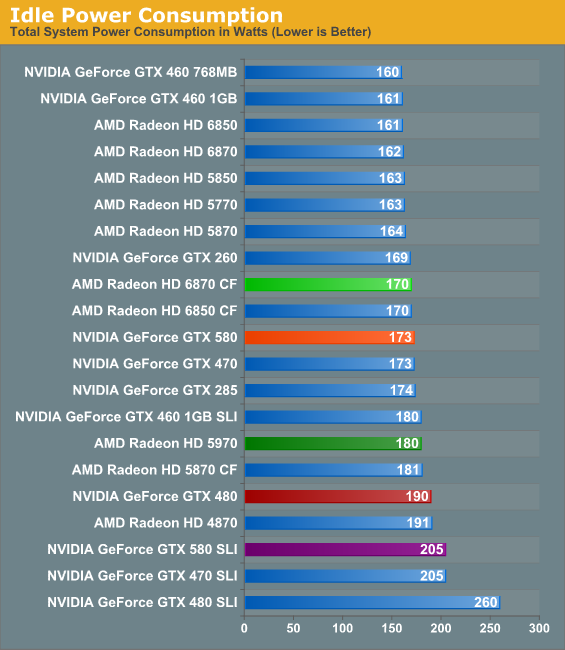
Beginning with idle power, we’re seeing our second biggest sign that NVIDIA has been tweaking things specifically to combat leakage. Idle power consumption has dropped by 17W on our test system even though the idle clocks are the same and the idle voltage higher. NVIDIA doesn’t provide an idle power specification, but based on neighboring cards idle power consumption can’t be far off from 30-35W. Amusingly it still ends up being more than the 6870 CF however, thanks to the combination of AMD’s smaller GPUs and ULPS power saving mode for the slave GPU.
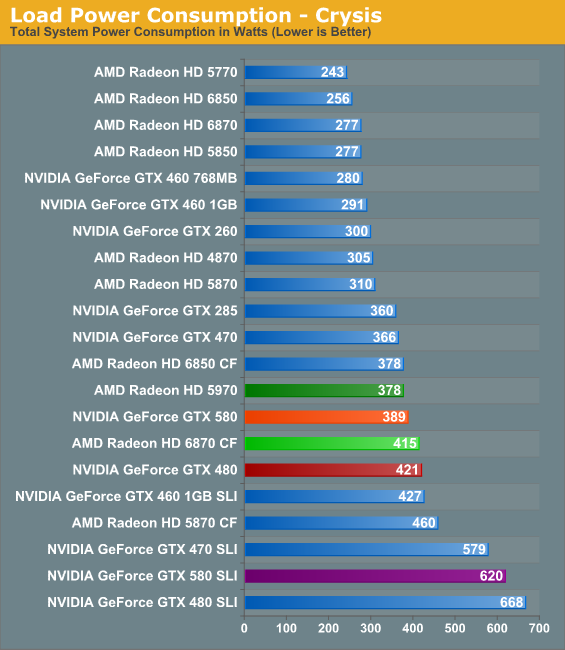
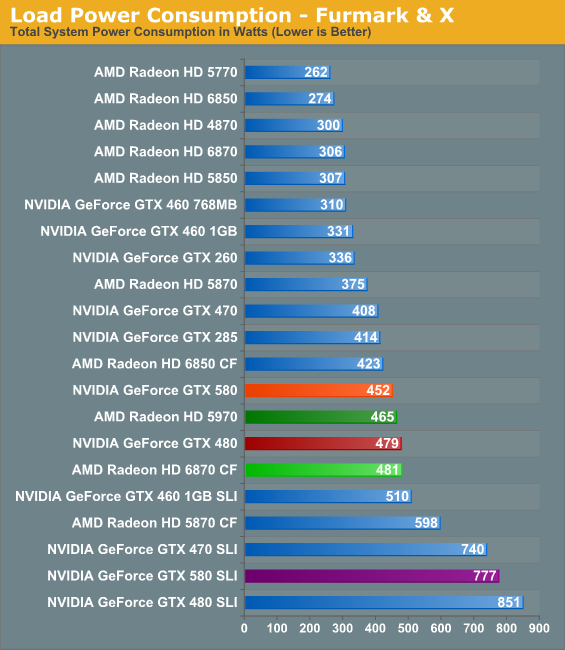
Looking at Crysis, we begin to see the full advantage of NVIDIA’s optimizations and where a single GPU is more advantageous over multiple GPUs. Compared to the GTX 480 NVIDIA’s power consumption is down 10% (never mind the 15% performance improvement), and power consumption comes in under all similar multi-GPU configurations. Interestingly the 5970 still draws less power here, a reminder that we’re still looking at cards near the peak of the PCIe specifications.
As for FurMark, due to NVIDIA’s power throttling we’ve had to get a bit creative. FurMark is throttled to the point where the GTX 580 registers 360W, thanks to a roughly 40% reduction in performance under FurMark. As a result for the GTX 580 we’ve swapped out FurMark for another program that generates a comparable load, Program X. At this point we’re going to decline to name the program, as should NVIDIA throttle it we may be hard pressed to determine if and when this happened.
In any case, under FurMark & X we can see that once again NVIDIA’s power consumption has dropped versus the GTX 480, this time by 27W or around 6%. NVIDIA’s worst case scenario has notably improved, and in the process the GTX 580 is back under the Radeon HD 5970 in terms of power consumption. Thus it goes without saying that while NVIDIA has definitely improved power consumption, the GTX 580 is still a large, power hungry GPU.
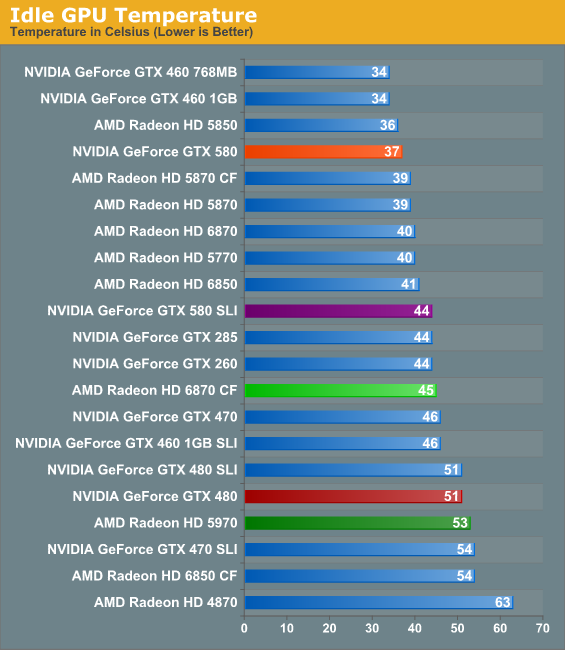
With NVIDIA’s improvements in cooling and in idle power consumption, there’s not a result more dramatic than idle GPU temperatures. The GTX 580 isn’t just cooler, it’s cool period. 37C is one of the best results out of any of our midrange and high-end GPUs, and is a massive departure from the GTX 480 which was at least warm all the time. As we’ll see however, this kind of an idle temperature does come with a small price.
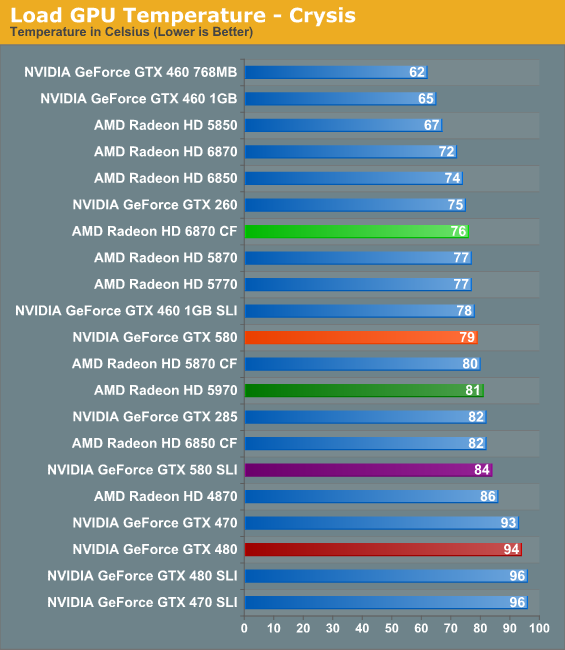
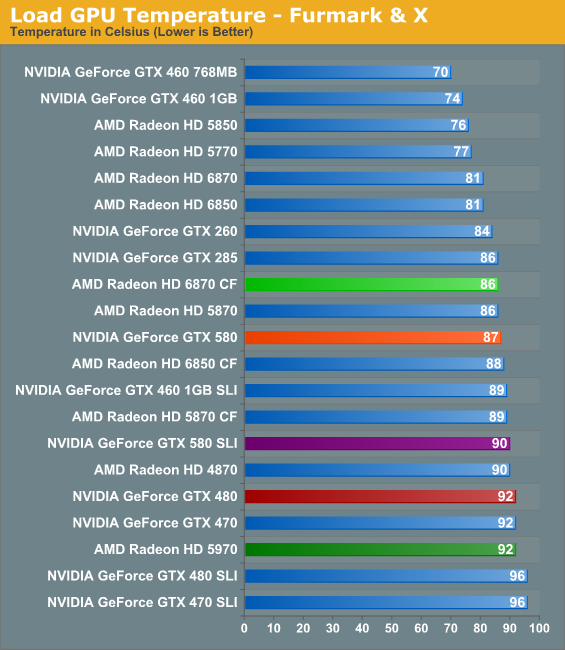
The story under load is much the same as idle: compared to the GTX 480 the GTX 580’s temperatures have dramatically dropped. At 79C it’s in the middle of the pack, beating a number of single and multi GPU setups, and really only losing to mainstream-class GPUs and the 6870 CF. While we’ve always worried about the GTX 480 at its load temperatures, the GTX 580 leaves us with no such concerns.
Meanwhile under FurMark and Program X, the gap has closed, though the GTX 580 remains in the middle of the pack. 87C is certainly toasty, but it’s still well below the thermal threshold and below the point where we’d be worried about it. Interestingly however, the GTX 580 is actually just a bit closer to its thermal threshold than the GTX 480 is; NVIDIA rated the 480 for 105C, while the 580 is rated for 97C. We’d like to say this vindicates our concerns about the GTX 480’s temperatures, but it’s more likely that this is a result of the transistors NVIDIA is using.
It’s also worth noting that NVIDIA seems to have done away with the delayed fan ramp-up found on the GTX 480. The fan ramping on the GTX 580 is as near as we can tell much more traditional, with the fan immediately ramping up with higher temperatures. For the purposes of our tests, this keeps the temperatures from spiking as badly.
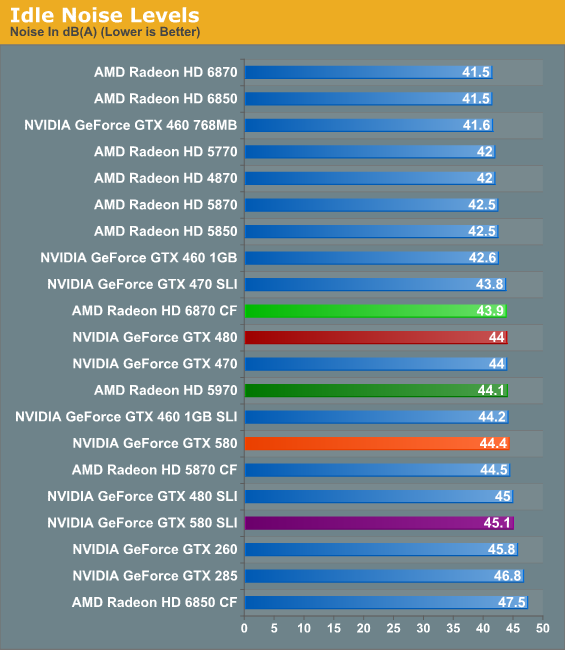
Remember where we said there was a small price to pay for such low idle temperatures? This is it. At 44.4dB, the 580 is ever so slightly (and we do mean slightly) louder than the GTX 480; it also ends up being a bit louder than the 5970 or 6870CF. 44.4 is not by any means loud, but if you want a card that’s whisper silent at idle, the GTX 580 isn’t going to be able to deliver.
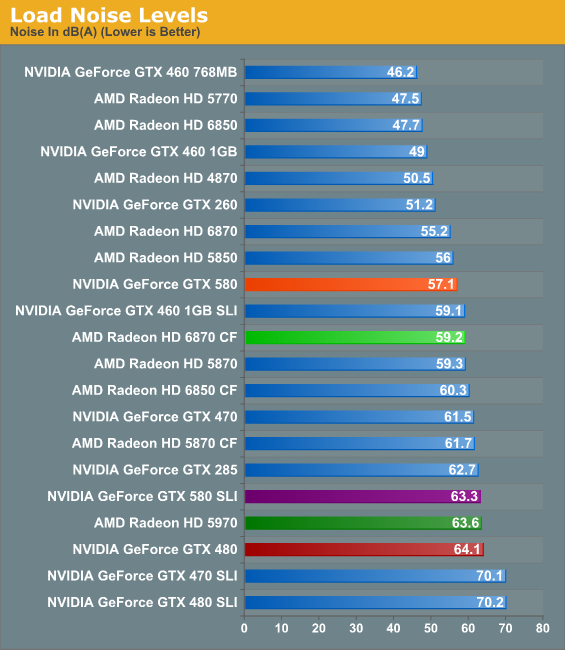
And last but not least is load noise. Between their improvements to power consumption and to cooling, NVIDIA put a lot of effort in to the amount of noise the GTX 580 generates. Where the GTX 480 set new records for a single GPU card, the GTX 580 is quieter than the GTX 285, the GTX 470, and even the Radeon HD 5870. In fact it’s only a dB off of the 5850, a card under most circumstances we’d call the epitome of balance between performance and noise. Graphs alone cannot demonstrate just how much of a difference there is between the GTX 480 and GTX 580 – the GTX 580 is not whisper quiet, but at no point in our testing did it ever get “loud”. It’s a truly remarkable difference; albeit one that comes at the price of pointing out just how lousy the GTX 480 was.
Often the mark of a good card is a balance between power, temperature, and noise, and NVIDIA seems to have finally found their mark. As the GTX 580 is a high end card the power consumption is still high, but it’s no longer the abnormality that was the GTX 480. Meanwhile GPU temperatures have left our self-proclaimed danger zone, and yet at the same time the GTX 580 has become a much quieter card under load than the GTX 480. If you had asked us in what NVIDIA needed to work on with the GTX 480, we would have said noise, temperature, and power consumption in that order; the GTX 580 delivers on just what we would have wanted.










160 Comments
View All Comments
StevoLincolnite - Tuesday, November 9, 2010 - link
I would have called them the 6750/6770 personally... Or at the very least the 6830/6850.There were also some architectural changes in the GTX 580 as well.
slickr - Tuesday, November 9, 2010 - link
Whats real and whats not real for you?6850 and 6870 are essentially more shaders, rops and higher clocks with few architectural improvements.
It will be same for the 6900 series.
GTX 580 again is same as the above, few architectural improvements, higher shaders, textures and clocks.
Credit must be given where its due and even though this was supposed to be the 480, its still a great product by its own, its faster, cooler, quieter and less power hungry.
ninjaquick - Thursday, December 2, 2010 - link
Umm, 6850 and 6870 are DECREASES on all but ROPs and Clocks. The architecture is only similar and very much evolutionary:numbers are: Universal Shader : Texture Mapping Unit : Render Output unit.
5850: 1440:72:32
6850: 960:48:32
5870: 1600:80:32
6870: 1120:56:32
So, 5-10% slower and 33% component shrink, which is to say ~1.4x perf increase per shader. So a full blown (6970) NI at an assumed 1600 shaders like the previous gen would be the rough equivalent of a 2400 shader evergreen when it comes to raw performance, so 1.4 to 1.5 times faster. It can be safely assumed that the shader performance will be higher than 2 5830s in CFX. 2 5830s are about 30% faster than a GTX 580.
That is theoretical performance based on a lot of assumptions and Ideal drivers. My point is NI is not a ground up redesign but it is a vastly superior and vastly different architecture to Evergreen.
boe - Thursday, November 18, 2010 - link
I can't wait to see a comparison with the 6970. I don't know which will win but it will help me decide which to get - I'm still using a 4870 so I'm ready for something new!The other thing that will help me decide is card options. The 4870 had some very nice "pre-silenced" modified cards right after release. The 6870 already has some "pre-silenced" cards on the market. The factory standard 580 is pretty loud although it is quieter than the 480 by far. I'm hoping there will be some modified 580's on the market with much quieter but at least as effective cooling solutions.
Will Robinson - Tuesday, November 9, 2010 - link
This is a much better effort than GTX480.Cooler,quieter and faster.
AMD will have a tough fight on their hands with Cayman XT versus this new part.
StevoLincolnite - Tuesday, November 9, 2010 - link
Can't wait for a price war, something that seemed to be missing with Fermi and the 5xxx series.Sihastru - Tuesday, November 9, 2010 - link
Let's hope so. This way both fanbois camps will win when it comes to how much lighter their wallets will be after their purchase (in some cases their parents wallets - only children act like fanbois).B3an - Wednesday, November 10, 2010 - link
I -wish- only children acted like fanboys. The fact is that a lot of these guys are well into there 20's and 30's.They really are pathetic people.
mino - Tuesday, November 9, 2010 - link
Well not that it was hard to beat 480 ... that part was not ready for prime time in the first place.dragonsqrrl - Wednesday, March 18, 2015 - link
...lol, facepalm.